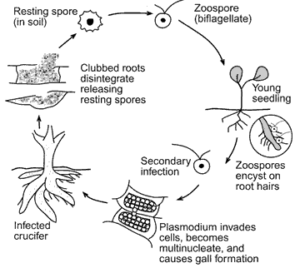Clubroot
Clubroot is a serious soil-bourne disease in cruciferous crops, most notably canola.
The disease causes galls or clubs to form on the root structure of the plant and then the premature death of the plant. Yield losses are estimated to be half of the percentage of infected stems. If you had 100% infestation, you would expect 50% yield loss. Once clubroot infests a field it is impossible to eradicate. Spores can reside in the soil for up to 20 years!
Read more about the ravages of clubroot and what you can do about it.
Clubroot is spread by soil transported by wind or water erosion, on farm machinery, in manure from animals fed infected feed, and attached to seeds (earth tags). It is often first detected in fields at their entrance. Those accessing a field can potentially infect it; construction, utilities, petroleum industries, recreation vehicles, hunters, and custom operators/sprayers included. Livestock, manure, hay, straw, seed, rental equipment, and even footwear can equally be to blame to clubroot spread.
The rise of clubroot has been rapid across the province since it was first detected near Edmonton in 2003.
Prevention is paramount to protect yourself against clubroot.
The best defense is good sanitation. Remove soil clumps and crop debris. Wash equipment with hot water or steam, disinfect it with a weak 1-2% bleach solution, and let it sit for 10-15 minutes to remove any remaining spores.
Restrict access to your fields and be weary of equipment purchases (especially used) as they may be coming from an area already infected with clubroot.
Practice field soil conservation to reduce the amount of erosion. Avoid the use of straw or hay from areas that may contain clubroot. Manage weeds and volunteers, especially those in the mustard or Brassica families, and dock and hoary cress, as they are all clubroot hosts.
Use long rotations; this will not completely prevent clubroot but rather slow its progression as its spore half-life is 4 years.
Scout your fields! The optimal time to scout fields is 2 weeks prior to swathing when the galls are most evident. To scout your fields:
- First assess your field as a whole. Look for patches of the crop that exhibit wilting or stressed symptoms, premature ripening, stunting, and yellowing of plants.
- If you find plants with symptoms, dig up a few plants to check for galls on the roots to properly diagnose clubroot infection. Keep in mind it takes 6 weeks from initial infection for the galls to form.
- Take steps to ensure no soil is transported between fields while scouting.
What to do if you have an infected field
If your field is infested with clubroot, getting rid of it will take a long-term management strategy.
Use long rotations (four per year) to help prevent the accumulation of resting clubroot spores. This isn’t a magic solution, however, and will not completely eliminate or prevent the spread of clubroot.
Use clubroot resistant crop varieties. (Keep in mind even resistant varieties are not immune to clubroot—1-4% of seed is susceptible).
Assume some infected plants to be attributed to volunteers and weeds.
Minimize traffic into the fields and commit to performing good sanitation practices. Avoid working in wet fields as mud will easily stick to equipment and be transferred to other sites. Work the infected field last so you are less likely to spread the disease.
Manage the disease with best management practices, being proactive and scouting your fields.
Learn More
To learn about the Alberta Clubroot Management Plan, contact your local Agricultural Fieldman, the Lakeland Agricultural Research Association, or visit the Alberta Ministry of Agriculture and Forestry website.


